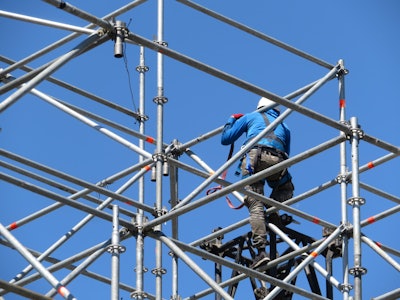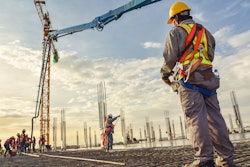
Scaffolding is used on construction or renovation worksites as a temporary structure to support and allow workers to perform their duties. It is often used off the ground, at raised or higher levels. Proper scaffolding is usually built out of wood and/or steel and is durable enough to safely hold the full weight of construction workers and any required equipment.
However, the U.S. Bureau of Labor Statistics (BLS) reports that over 62% of construction workers are exposed to heights where their center of gravity is more than 5 feet off the ground. Working at heights of any level increases these workers’ risk of injury from falling. And in 2020, 3,250 workers suffered injuries due to scaffolding.
Common Scaffolding Hazards
A few of the most common scaffolding hazards include:
- A lack of fall protection equipment leading to falls from an elevated height
- Overloading or instability of the scaffold causing it to collapse
- Workers being struck by falling items from the scaffold, such as tools, materials or debris
- Proximity to overhead power lines leading to the risk of electrocution
Falls are the leading cause of death for construction workers, and 86% of scaffolding deaths are in the construction industry. Why is this number so high? Several factors contribute to the higher risk of scaffolding falls, such as:
- Lack of fall protection for the worker and no fall protection program in place
- Inexperienced or untrained workers who cannot identify common fall hazards
- Unstable work surfaces with no guardrails or wheels left unlocked before a worker climbs the platform
- Workers left alone on scaffolding during off hours
Scaffolding Safety: OSHA Regulations and Employee Training
OSHA has had a standard in place for scaffolding safety since 1971, and it has been updated several times throughout the years. This rule spells out the safety standards that regulate the design, construction and use of scaffolds in the construction industry. It explains fall protection systems and describes the training any employees using scaffolding should undergo before they are permitted to use them.
Employers are responsible for ensuring compliance with OSHA’s regulations, and workers should be properly trained and familiarized with them. Some of the rules the OSHA standard states that employers must comply with include:
- Weight capacity requirements for all scaffolds
- Scaffold platform construction requirements
- Criteria for supported scaffolds and suspended scaffolds
- Access and use requirements
- Fall protection requirements
- Falling object protection
OSHA also offers training courses on scaffold safety. In 1996, when OSHA revised its scaffold standards, the Bureau of Labor and Statistics found that 25% of workers received no training on scaffold safety. Training is key in protecting workers from debilitating accidents due to scaffolding.
Scaffold Accident and Fall Prevention Tips
Scaffolding accidents can lead to serious injuries and, in some cases, even death. Workers can fall from an unstable scaffold or from unsafe working conditions, such as working outside on scaffolding during inclement weather. Without proper safety measures in place, scaffolding can be a hazard to the employees utilizing it and to others working nearby. Seven essential scaffolding safety tips to follow include:
1. Perform An Inspection Before Use
Before allowing workers to mount scaffolding, perform a thorough inspection to ensure all components are secure, tight and undamaged. Check for things like missing or damaged guardrails, ties or connectors.
2. Use Fall Protection
Make sure that guardrails are in place and secure. Workers should also wear personal protective equipment, including hard hats, harnesses and lanyards when working at heights.
3. Follow Load Capacity Guidelines
Never exceed the maximum load capacity of the scaffold. OSHA states that “each scaffold and scaffold component must support without failure its own weight and at least four times the maximum intended load applied or transmitted to it.” Additionally, make sure to distribute weight evenly and not overload one side of the scaffold.
4. Ensure The Scaffold Is Secure
Scaffolds should be restrained by tying, bracing or something equivalent to these means. Scaffolds must also be securely fastened to the building structure to prevent movement or tipping.
5. Maintain A Safe Work Area
Warning signs should be placed around the scaffold to alert workers and pedestrians of potential hazards. Additionally, keep the work area free of clutter and debris and quickly clean up any spills that could cause slippery surfaces near the scaffold.
6. Use Proper Access
According to OSHA, employers must provide access when the scaffold platforms are more than two feet above ground or below a point of access. Safe and secure access to the scaffold by using ladders or stairs should be used, not items like boxes or other unstable objects.
7. Trained Workers
All employees need regular training by a qualified individual to ensure they can recognize the common scaffolding hazards and understand how to minimize them. Training should include sessions on the specific hazards, including falls, falling objects, and electrical concerns, as well as how to properly use the scaffold and handle materials once on it. Only trained workers should be allowed to use scaffolding.
Taking these precautions can prevent employee accidents, minimize downtime, and improve the overall efficiency of a construction project.



















